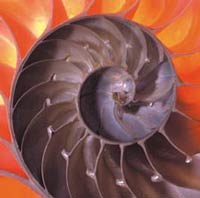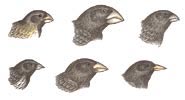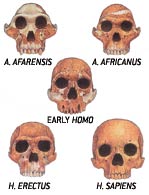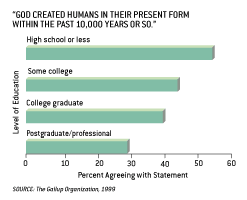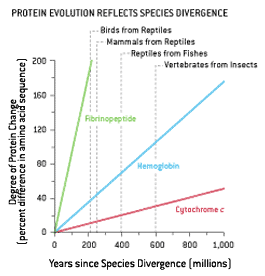
| Home | VISION & THE ILLUSION OF THE GHOST IN THE MACHINE--JK | WHY THE BRAIN IS NOT LIKE A COMPUTER--JK | THOUGHT AND THE ILLUSION OF A GHOST IN THE MACHINE--JK | Free Will and Free Won't --American Scientist | BIOFIELD THEORY: PHYSICS CONTRA SPIRITUAL ENERGY | Quantum Quackery | Dr. Deepak Chopra's secrets of enlightenment | HOCUS FOCUS | CREATIONSTS FAILED EXAMPLES AGAINST EVOLUTION | Creationism, Their Mind is on Vacation | Homeopathy: Its history , its folly | Psychics, Police Departments Evaluations | "What the #$*! Do We Know": popular pseudoscience film reviewed | Christian Science, a religion that practices faith healing | NOSTRADAMUS: His Prophecies--Randi | Edgar Cayce, Cult Figure & New Age Prophet--by believer | Mayan Calendar and the End of Time | |||||||||||||||||
|
spiritualism
|
|||||||||||||||||
|
CREATIONSTS FAILED EXAMPLES AGAINST EVOLUTION
|
|||||||||||||||||
|
|
|||||||||||||||||
|
15 Answers to Creationist Nonesense By Hohn Rennie--Editor in Chief of Scientific American Published in the July 2002 issue of Scientific American Opponents
of evolution want to make a place for creationism by tearing down real science, but their arguments don't hold up By John Rennie
lAYNE KENNEDY Corbis NAUTILUS SHELL:
Designed or evolved? When Charles
Darwin introduced the theory of evolution through natural selection 143 years ago, the scientists of the day argued over it
fiercely, but the massing evidence from paleontology, genetics, zoology, molecular biology and other fields gradually established
evolution's truth beyond reasonable doubt. Today that battle has been won everywhere--except in the public imagination. Embarrassingly, in the 21st century, in the most scientifically
advanced nation the world has ever known, creationists can still persuade politicians, judges and ordinary citizens that evolution
is a flawed, poorly supported fantasy. They lobby for creationist ideas such as "intelligent design" to be taught as alternatives
to evolution in science classrooms. As this article goes to press, the Ohio Board of Education is debating whether to mandate
such a change. Some antievolutionists, such as Philip E. Johnson, a law professor at the University of California at Berkeley
and author of Darwin on Trial, admit that they intend for intelligent-design theory to serve as a "wedge" for reopening
science classrooms to discussions of God. Besieged teachers and others may increasingly find themselves
on the spot to defend evolution and refute creationism. The arguments that creationists use are typically specious and based
on misunderstandings of (or outright lies about) evolution, but the number and diversity of the objections can put even well-informed
people at a disadvantage. To help with answering them, the following list rebuts
some of the most common "scientific" arguments raised against evolution. It also directs readers to further sources for information
and explains why creation science has no place in the classroom. 1. Evolution is only a theory. It is not a fact or a
scientific law. Many people learned in elementary school that a theory falls
in the middle of a hierarchy of certainty--above a mere hypothesis but below a law. Scientists do not use the terms that way,
however. According to the National Academy of Sciences (NAS), a scientific theory is "a well-substantiated explanation of
some aspect of the natu
PATRICIA J.
WYNNE GALÁPAGOS FINCHES show adaptive beak shapes. ral world that can incorporate facts, laws, inferences,
and tested hypotheses." No amount of validation changes a theory into a law, which is a descriptive generalization about nature.
So when scientists talk about the theory of evolution--or the atomic theory or the theory of relativity, for that matter--they
are not expressing reservations about its truth. In addition to the theory of evolution, meaning the
idea of descent with modification, one may also speak of the fact of evolution. The NAS defines a fact as "an observation
that has been repeatedly confirmed and for all practical purposes is accepted as 'true.'" The fossil record and abundant other
evidence testify that organisms have evolved through time. Although no one observed those transformations, the indirect evidence
is clear, unambiguous and compelling. All sciences frequently rely on indirect evidence. Physicists
cannot see subatomic particles directly, for instance, so they verify their existence by watching for telltale tracks that
the particles leave in cloud chambers. The absence of direct observation does not make physicists' conclusions less certain.
2. Natural selection is based on circular reasoning:
the fittest are those who survive, and those who survive are deemed fittest. "Survival of the fittest" is a conversational way to describe
natural selection, but a more technical description speaks of differential rates of survival and reproduction. That is, rather
than labeling species as more or less fit, one can describe how many offspring they are likely to leave under given circumstances.
Drop a fast-breeding pair of small-beaked finches and a slower-breeding pair of large-beaked finches onto an island full of
food seeds. Within a few generations the fast breeders may control more of the food resources. Yet if large beaks more easily
crush seeds, the advantage may tip to the slow breeders. In a pioneering study of finches on the Galápagos Islands, Peter
R. Grant of Princeton University observed these kinds of population shifts in the wild [see his article "Natural Selection
and Darwin's Finches"; Scientific American, October 1991].
REPRINTED BY PERMISSION OF WADSWORTH/THOMSON LEARNING FROM BIOLOGY: CONCEPTS AND APPLICATIONS, BY CECIE
STARR, © 1991 SKULLS of
some hominids predating modern humans (Homo sapiens). The key is that adaptive fitness can be defined without
reference to survival: large beaks are better adapted for crushing seeds, irrespective of whether that trait has survival
value under the circumstances. 3. Evolution is unscientific, because it is not testable
or falsifiable. It makes claims about events that were not observed and can never be re-created. This blanket dismissal of evolution ignores important distinctions
that divide the field into at least two broad areas: microevolution and macroevolution. Microevolution looks at changes within
species over time--changes that may be preludes to speciation, the origin of new species. Macroevolution studies how taxonomic
groups above the level of species change. Its evidence draws frequently from the fossil record and DNA comparisons to reconstruct
how various organisms may be related. These days even most creationists acknowledge that microevolution
has been upheld by tests in the laboratory (as in studies of cells, plants and fruit flies) and in the field (as in Grant's
studies of evolving beak shapes among Galápagos finches). Natural selection and other mechanisms--such as chromosomal changes,
symbiosis and hybridization--can drive profound changes in populations over time. The historical nature of macroevolutionary study involves
inference from fossils and DNA rather than direct observation. Yet in the historical sciences (which include astronomy, geology
and archaeology, as well as evolutionary biology), hypotheses can still be tested by checking whether they accord with physical
evidence and whether they lead to verifiable predictions about future discoveries. For instance, evolution implies that between
the earliest-known ancestors of humans (roughly five million years old) and the appearance of anatomically modern humans (about
100,000 years ago), one should find a succession of hominid creatures with features progressively less apelike and more modern,
which is indeed what the fossil record shows. But one should not--and does not--find modern human fossils embedded in strata
from the Jurassic period (144 million years ago). Evolutionary biology routinely makes predictions far more refined and precise
than this, and researchers test them constantly. Evolution could be disproved in other ways, too. If we could
document the spontaneous generation of just one complex life-form from inanimate matter, then at least a few creatures seen
in the fossil record might have originated this way. If superintelligent aliens appeared and claimed credit for creating life
on earth (or even particular species), the purely evolutionary explanation would be cast in doubt. But no one has yet produced
such evidence. It should be noted that the idea of falsifiability as the
defining characteristic of science originated with philosopher Karl Popper in the 1930s. More recent elaborations on his thinking
have expanded the narrowest interpretation of his principle precisely because it would eliminate too many branches of clearly
scientific endeavor. 4. Increasingly, scientists doubt the truth of evolution. No evidence suggests that evolution is losing adherents.
Pick up any issue of a peer-reviewed biological journal, and you will find articles that support and extend evolutionary studies
or that embrace evolution as a fundamental concept. Conversely, serious scientific publications disputing evolution
are all but nonexistent. In the mid-1990s George W. Gilchrist of the University of Washington surveyed thousands of journals
in the primary literature, seeking articles on intelligent design or creation science. Among those hundreds of thousands of
scientific reports, he found none. In the past two years, surveys done independently by Barbara Forrest of Southeastern Louisiana
University and Lawrence M. Krauss of Case Western Reserve University have been similarly fruitless. Creationists retort that a closed-minded scientific community
rejects their evidence. Yet according to the editors of Nature, Science and other leading journals, few antievolution
manuscripts are even submitted. Some antievolution authors have published papers in serious journals. Those papers, however,
rarely attack evolution directly or advance creationist arguments; at best, they identify certain evolutionary problems as
unsolved and difficult (which no one disputes). In short, creationists are not giving the scientific world good reason to
take them seriously.
CLEO VILETT 5. The disagreements among even evolutionary biologists
show how little solid science supports evolution.
Evolutionary biologists passionately debate diverse topics:
how speciation happens, the rates of evolutionary change, the ancestral relationships of birds and dinosaurs, whether Neandertals
were a species apart from modern humans, and much more. These disputes are like those found in all other branches of science.
Acceptance of evolution as a factual occurrence and a guiding principle is nonetheless universal in biology. Unfortunately, dishonest creationists have shown a willingness
to take scientists' comments out of context to exaggerate and distort the disagreements. Anyone acquainted with the works
of paleontologist Stephen Jay Gould of Harvard University knows that in addition to co-authoring the punctuated-equilibrium
model, Gould was one of the most eloquent defenders and articulators of evolution. (Punctuated equilibrium explains patterns
in the fossil record by suggesting that most evolutionary changes occur within geologically brief intervals--which may nonetheless
amount to hundreds of generations.) Yet creationists delight in dissecting out phrases from Gould's voluminous prose to make
him sound as though he had doubted evolution, and they present punctuated equilibrium as though it allows new species to materialize
overnight or birds to be born from reptile eggs. When confronted with a quotation from a scientific authority
that seems to question evolution, insist on seeing the statement in context. Almost invariably, the attack on evolution will
prove illusory. 6. If humans descended from monkeys, why are there still
monkeys? This surprisingly common argument reflects several levels
of ignorance about evolution. The first mistake is that evolution does not teach that humans descended from monkeys; it states
that both have a common ancestor. The deeper error is that this objection is tantamount to
asking, "If children descended from adults, why are there still adults?" New species evolve by splintering off from established
ones, when populations of organisms become isolated from the main branch of their family and acquire sufficient differences
to remain forever distinct. The parent species may survive indefinitely thereafter, or it may become extinct. 7. Evolution cannot explain how life first appeared on
earth. The origin of life remains very much a mystery, but biochemists
have learned about how primitive nucleic acids, amino acids and other building blocks of life could have formed and organized
themselves into self-replicating, self-sustaining units, laying the foundation for cellular biochemistry. Astrochemical analyses
hint that quantities of these compounds might have originated in space and fallen to earth in comets, a scenario that may
solve the problem of how those constituents arose under the conditions that prevailed when our planet was young. Creationists sometimes try to invalidate all of evolution
by pointing to science's current inability to explain the origin of life. But even if life on earth turned out to have a nonevolutionary
origin (for instance, if aliens introduced the first cells billions of years ago), evolution since then would be robustly
confirmed by countless microevolutionary and macroevolutionary studies. 8. Mathematically, it is inconceivable that anything
as complex as a protein, let alone a living cell or a human, could spring up by chance. Chance plays a part in evolution (for example, in the random
mutations that can give rise to new traits), but evolution does not depend on chance to create organisms, proteins or other
entities. Quite the opposite: natural selection, the principal known mechanism of evolution, harnesses nonrandom change by
preserving "desirable" (adaptive) features and eliminating "undesirable" (nonadaptive) ones. As long as the forces of selection
stay constant, natural selection can push evolution in one direction and produce sophisticated structures in surprisingly
short times.
CLEO VILETT As an analogy, consider the 13-letter sequence "TOBEORNOTTOBE."
Those hypothetical million monkeys, each pecking out one phrase a second, could take as long as 78,800 years to find it among
the 2613 sequences of that length. But in the 1980s Richard Hardison of Glendale College wrote a computer program that generated
phrases randomly while preserving the positions of individual letters that happened to be correctly placed (in effect, selecting
for phrases more like Hamlet's). On average, the program re-created the phrase in just 336 iterations, less than 90 seconds.
Even more amazing, it could reconstruct Shakespeare's entire play in just four and a half days. 9. The Second Law of Thermodynamics says that systems
must become more disordered over time. Living cells therefore could not have evolved from inanimate chemicals, and multicellular
life could not have evolved from protozoa. This argument derives from a misunderstanding of the Second
Law. If it were valid, mineral crystals and snowflakes would also be impossible, because they, too, are complex structures
that form spontaneously from disordered parts. The Second Law actually states that the total entropy of
a closed system (one that no energy or matter leaves or enters) cannot decrease. Entropy is a physical concept often casually
described as disorder, but it differs significantly from the conversational use of the word. More important, however, the Second Law permits parts of
a system to decrease in entropy as long as other parts experience an offsetting increase. Thus, our planet as a whole can
grow more complex because the sun pours heat and light onto it, and the greater entropy associated with the sun's nuclear
fusion more than rebalances the scales. Simple organisms can fuel their rise toward complexity by consuming other forms of
life and nonliving materials. 10. Mutations are essential to evolution theory, but
mutations can only eliminate traits. They cannot produce new features.
CLEO VILETT CLOSE-UP of a bacterial flagellum. On the contrary, biology has catalogued many traits produced
by point mutations (changes at precise positions in an organism's DNA)--bacterial resistance to antibiotics, for example.
Mutations that arise in the homeobox (Hox) family
of development-regulating genes in animals can also have complex effects. Hox genes direct where legs, wings, antennae
and body segments should grow. In fruit flies, for instance, the mutation called Antennapedia causes legs to sprout
where antennae should grow. These abnormal limbs are not functional, but their existence demonstrates that genetic mistakes
can produce complex structures, which natural selection can then test for possible uses. Moreover, molecular biology has discovered mechanisms for
genetic change that go beyond point mutations, and these expand the ways in which new traits can appear. Functional modules
within genes can be spliced together in novel ways. Whole genes can be accidentally duplicated in an organism's DNA, and the
duplicates are free to mutate into genes for new, complex features. Comparisons of the DNA from a wide variety of organisms
indicate that this is how the globin family of blood proteins evolved over millions of years. 11. Natural selection might explain microevolution, but
it cannot explain the origin of new species and higher orders of life. Evolutionary biologists have written extensively about how
natural selection could produce new species. For instance, in the model called allopatry, developed by Ernst Mayr of Harvard
University, if a population of organisms were isolated from the rest of its species by geographical boundaries, it might be
subjected to different selective pressures. Changes would accumulate in the isolated population. If those changes became so
significant that the splinter group could not or routinely would not breed with the original stock, then the splinter group
would be reproductively isolated and on its way toward becoming a new species.
12. Nobody
has ever seen a new species evolve. Speciation is probably fairly rare and in many cases might
take centuries. Furthermore, recognizing a new species during a formative stage can be difficult, because biologists sometimes
disagree about how best to define a species. The most widely used definition, Mayr's Biological Species Concept, recognizes
a species as a distinct community of reproductively isolated populations--sets of organisms that normally do not or cannot
breed outside their community. In practice, this standard can be difficult to apply to organisms isolated by distance or terrain
or to plants (and, of course, fossils do not breed). Biologists therefore usually use organisms' physical and behavioral traits
as clues to their species membership. Nevertheless, the scientific literature does contain reports
of apparent speciation events in plants, insects and worms. In most of these experiments, researchers subjected organisms
to various types of selection--for anatomical differences, mating behaviors, habitat preferences and other traits--and found
that they had created populations of organisms that did not breed with outsiders. For example, William R. Rice of the University
of New Mexico and George W. Salt of the University of California at Davis demonstrated that if they sorted a group of fruit
flies by their preference for certain environments and bred those flies separately over 35 generations, the resulting flies
would refuse to breed with those from a very different environment. 13. Evolutionists cannot point to any transitional
fossils--creatures that are half reptile and half bird, for instance. Actually, paleontologists know of many detailed examples
of fossils intermediate in form between various taxonomic groups. One of the most famous fossils of all time is Archaeopteryx,
which combines feathers and skeletal structures peculiar to birds with features of dinosaurs. A flock's worth of other feathered
fossil species, some more avian and some less, has also been found. A sequence of fossils spans the evolution of modern horses
from the tiny Eohippus. Whales had four-legged ancestors that walked on land, and creatures known as Ambulocetus
and Rodhocetus helped to make that transition [see "The Mammals That Conquered the Seas," by Kate Wong; Scientific
American, May]. Fossil seashells trace the evolution of various mollusks through millions of years. Perhaps 20 or more hominids
(not all of them our ancestors) fill the gap between Lucy the australopithecine and modern humans. Creationists, though, dismiss these fossil studies. They
argue that Archaeopteryx is not a missing link between reptiles and birds--it is just an extinct bird with reptilian
features. They want evolutionists to produce a weird, chimeric monster that cannot be classified as belonging to any known
group. Even if a creationist does accept a fossil as transitional between two species, he or she may then insist on seeing
other fossils intermediate between it and the first two. These frustrating requests can proceed ad infinitum and place an
unreasonable burden on the always incomplete fossil record. Nevertheless, evolutionists can cite further supportive
evidence from molecular biology. All organisms share most of the same genes, but as evolution predicts, the structures of
these genes and their products diverge among species, in keeping with their evolutionary relationships. Geneticists speak
of the "molecular clock" that records the passage of time. These molecular data also show how various organisms are transitional
within evolution. 14. Living things have fantastically intricate features--at
the anatomical, cellular and molecular levels--that could not function if they were any less complex or sophisticated. The
only prudent conclusion is that they are the products of intelligent design, not evolution. This "argument from design" is the backbone of most recent
attacks on evolution, but it is also one of the oldest. In 1802 theologian William Paley wrote that if one finds a pocket
watch in a field, the most reasonable conclusion is that someone dropped it, not that natural forces created it there. By
analogy, Paley argued, the complex structures of living things must be the handiwork of direct, divine invention. Darwin wrote
On the Origin of Species as an answer to Paley: he explained how natural forces of selection, acting on inherited features,
could gradually shape the evolution of ornate organic structures. Generations of creationists have tried to counter Darwin
by citing the example of the eye as a structure that could not have evolved. The eye's ability to provide vision depends on
the perfect arrangement of its parts, these critics say. Natural selection could thus never favor the transitional forms needed
during the eye's evolution--what good is half an eye? Anticipating this criticism, Darwin suggested that even "incomplete"
eyes might confer benefits (such as helping creatures orient toward light) and thereby survive for further evolutionary refinement.
Biology has vindicated Darwin: researchers have identified primitive eyes and light-sensing organs throughout the animal kingdom
and have even tracked the evolutionary history of eyes through comparative genetics. (It now appears that in various families
of organisms, eyes have evolved independently.) Today's intelligent-design advocates are more sophisticated
than their predecessors, but their arguments and goals are not fundamentally different. They criticize evolution by trying
to demonstrate that it could not account for life as we know it and then insist that the only tenable alternative is that
life was designed by an unidentified intelligence. 15. Recent discoveries prove that even at the microscopic
level, life has a quality of complexity that could not have come about through evolution. "Irreducible complexity" is the battle cry of Michael J.
Behe of Lehigh University, author of Darwin's Black Box: The Biochemical Challenge to Evolution. As a household example
of irreducible complexity, Behe chooses the mousetrap--a machine that could not function if any of its pieces were missing
and whose pieces have no value except as parts of the whole. What is true of the mousetrap, he says, is even truer of the
bacterial flagellum, a whiplike cellular organelle used for propulsion that operates like an outboard motor. The proteins
that make up a flagellum are uncannily arranged into motor components, a universal joint and other structures like those that
a human engineer might specify. The possibility that this intricate array could have arisen through evolutionary modification
is virtually nil, Behe argues, and that bespeaks intelligent design. He makes similar points about the blood's clotting mechanism
and other molecular systems. Yet evolutionary biologists have answers to these objections.
First, there exist flagellae with forms simpler than the one that Behe cites, so it is not necessary for all those components
to be present for a flagellum to work. The sophisticated components of this flagellum all have precedents elsewhere in nature,
as described by Kenneth R. Miller of Brown University and others. In fact, the entire flagellum assembly is extremely similar
to an organelle that Yersinia pestis, the bubonic plague bacterium, uses to inject toxins into cells. The key is that the flagellum's component structures, which
Behe suggests have no value apart from their role in propulsion, can serve multiple functions that would have helped favor
their evolution. The final evolution of the flagellum might then have involved only the novel recombination of sophisticated
parts that initially evolved for other purposes. Similarly, the blood-clotting system seems to involve the modification and
elaboration of proteins that were originally used in digestion, according to studies by Russell F. Doolittle of the University
of California at San Diego. So some of the complexity that Behe calls proof of intelligent design is not irreducible at all.
Complexity of a different kind--"specified complexity"--is
the cornerstone of the intelligent-design arguments of William A. Dembski of Baylor University in his books The Design
Inference and No Free Lunch. Essentially his argument is that living things are complex in a way that undirected,
random processes could never produce. The only logical conclusion, Dembski asserts, in an echo of Paley 200 years ago, is
that some superhuman intelligence created and shaped life. Dembski's argument contains several holes. It is wrong to
insinuate that the field of explanations consists only of random processes or designing intelligences. Researchers into nonlinear
systems and cellular automata at the Santa Fe Institute and elsewhere have demonstrated that simple, undirected processes
can yield extraordinarily complex patterns. Some of the complexity seen in organisms may therefore emerge through natural
phenomena that we as yet barely understand. But that is far different from saying that the complexity could not have arisen
naturally. "Creation science" is a contradiction in terms. A central
tenet of modern science is methodological naturalism--it seeks to explain the universe purely in terms of observed or testable
natural mechanisms. Thus, physics describes the atomic nucleus with specific concepts governing matter and energy, and it
tests those descriptions
A broadcast version
of this article will air June 26 on National Geographic Today, a program on the National Geographic Channel. Please check
your local listings experimentally. Physicists introduce new particles, such
as quarks, to flesh out their theories only when data show that the previous descriptions cannot adequately explain observed
phenomena. The new particles do not have arbitrary properties, moreover--their definitions are tightly constrained, because
the new particles must fit within the existing framework of physics. In contrast, intelligent-design theorists invoke shadowy
entities that conveniently have whatever unconstrained abilities are needed to solve the mystery at hand. Rather than expanding
scientific inquiry, such answers shut it down. (How does one disprove the existence of omnipotent intelligences?) Intelligent design offers few answers. For instance,
when and how did a designing intelligence intervene in life's history? By creating the first DNA? The first cell? The first
human? Was every species designed, or just a few early ones? Proponents of intelligent-design theory frequently decline to
be pinned down on these points. They do not even make real attempts to reconcile their disparate ideas about intelligent design.
Instead they pursue argument by exclusion--that is, they belittle evolutionary explanations as far-fetched or incomplete and
then imply that only design-based alternatives remain.
Logically, this is misleading: even if one naturalistic
explanation is flawed, it does not mean that all are. Moreover, it does not make one intelligent-design theory more reasonable
than another. Listeners are essentially left to fill in the blanks for themselves, and some will undoubtedly do so by substituting
their religious beliefs for scientific ideas. Time and again, science has shown that methodological
naturalism can push back ignorance, finding increasingly detailed and informative answers to mysteries that once seemed impenetrable:
the nature of light, the causes of disease, how the brain works. Evolution is doing the same with the riddle of how the living
world took shape. Creationism, by any name, adds nothing of intellectual value to the effort. |
|||||||||||||||||
|
|
|||||||||||||||||
|
|
|||||||||||||||||
